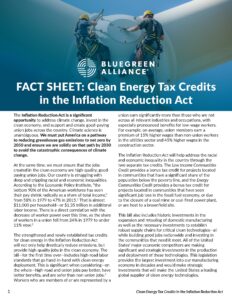
Fact Sheets and BlueGreen Alliance Resources
These fact sheets, program specific user guides, toolkits, maps, and reports break down the investments in the Inflation Reduction Act and Bipartisan Infrastructure Law:
FACT SHEET: CLEAN ENERGY TAX CREDITS IN THE INFLATION REDUCTION ACT
The strengthened and newly established tax credits for clean energy in the Inflation Reduction Act will not only help drastically reduce emissions, but provide high-quality jobs in the clean economy. The bill—for the first time ever—includes high-road labor standards that go hand-in-hand with clean energy deployment. This is significant when considering—on the whole—high-road and union jobs pay better, have better benefits, and are safer than non-union jobs.
FACT SHEET: CLEAN MANUFACTURING INVESTMENTS IN THE INFLATION REDUCTION ACT
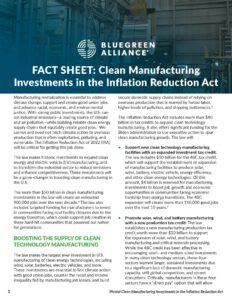 The Inflation Reduction Act makes historic investments to expand clean energy and electric vehicle manufacturing, and to transform the industrial sector to reduce emissions and enhance competitiveness. These investments will be a game-changer in boosting clean manufacturing in the United States. Manufacturing revitalization is essential to address climate change, support and create good union jobs, and advance racial, economic, and environmental justice. With strong public investments, the U.S. can cut industrial emissions—a leading source of climate and air pollution—while building reliable clean energy supply chains that equitably create good jobs. We cannot and need not hitch climate action to overseas production that is often exploitative, polluting, and vulnerable. The Inflation Reduction Act of 2022 will be critical for getting this job done.
The Inflation Reduction Act makes historic investments to expand clean energy and electric vehicle manufacturing, and to transform the industrial sector to reduce emissions and enhance competitiveness. These investments will be a game-changer in boosting clean manufacturing in the United States. Manufacturing revitalization is essential to address climate change, support and create good union jobs, and advance racial, economic, and environmental justice. With strong public investments, the U.S. can cut industrial emissions—a leading source of climate and air pollution—while building reliable clean energy supply chains that equitably create good jobs. We cannot and need not hitch climate action to overseas production that is often exploitative, polluting, and vulnerable. The Inflation Reduction Act of 2022 will be critical for getting this job done.
FACT SHEET: CLEAN VEHICLE PROVISIONS IN THE INFLATION REDUCTION ACT
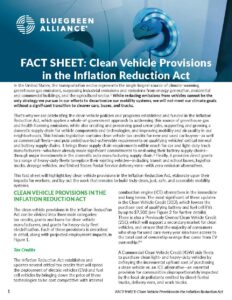 We’re celebrating the clean vehicle policies and programs established and funded in the Inflation Reduction Act, which applies a whole-of-government approach to addressing this source of greenhouse gas and health-harming emissions, while also creating and preserving good union jobs, supporting and growing a domestic supply chain for vehicle components and technologies, and improving mobility and air quality in our neighborhoods. This fact sheet will highlight key clean vehicle provisions in the Inflation Reduction Act, elaborate upon their impacts for workers, and lay out the work that remains to build truly clean, just, safe, and accessible mobility systems.
We’re celebrating the clean vehicle policies and programs established and funded in the Inflation Reduction Act, which applies a whole-of-government approach to addressing this source of greenhouse gas and health-harming emissions, while also creating and preserving good union jobs, supporting and growing a domestic supply chain for vehicle components and technologies, and improving mobility and air quality in our neighborhoods. This fact sheet will highlight key clean vehicle provisions in the Inflation Reduction Act, elaborate upon their impacts for workers, and lay out the work that remains to build truly clean, just, safe, and accessible mobility systems.
ROADMAP TO NAVIGATING FEDERAL FUNDING FOR PUBLIC BUILDINGS
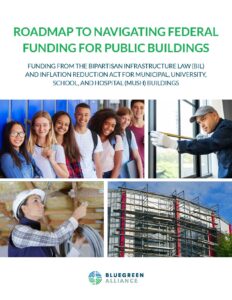 The 117th Congress passed historic infrastructure legislation that can be utilized to retrofit buildings, including Municipal, University, School, and Hospital (MUSH) buildings. MUSH buildings are particularly important, serving as essential community assets that represent significant opportunities to reduce greenhouse gas emissions, improve health outcomes, build climate resilience, and support and create good, local jobs all while addressing equity and environmental justice. The objective of this roadmap is to identify the federal funding opportunities available through the Inflation Reduction Act, The Bipartisan Infrastructure Law, and, in the case of schools, the American Rescue Plan, that can be used to upgrade MUSH buildings.
The 117th Congress passed historic infrastructure legislation that can be utilized to retrofit buildings, including Municipal, University, School, and Hospital (MUSH) buildings. MUSH buildings are particularly important, serving as essential community assets that represent significant opportunities to reduce greenhouse gas emissions, improve health outcomes, build climate resilience, and support and create good, local jobs all while addressing equity and environmental justice. The objective of this roadmap is to identify the federal funding opportunities available through the Inflation Reduction Act, The Bipartisan Infrastructure Law, and, in the case of schools, the American Rescue Plan, that can be used to upgrade MUSH buildings.
MAP AND ANALYSIS: BUILDING A STRONG MANUFACTURING BASE FOR CLEAN ENERGY IN THE US
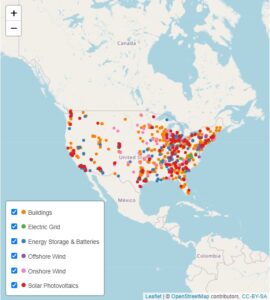 The clean technology supply chain analysis below can help federal and state policymakers, advocates, developers, journalists, and others trying to break down the complexity of domestic supply chains for clean energy. The map and spreadsheet below show how we can use new investments in the Inflation Reduction Act to bridge supply chain gaps and build a stronger, cleaner, and fairer industrial base for the clean economy in the U.S. Instead of hitching our climate goals to exploitative, vulnerable, and polluting production overseas, we have the means to build durable, equitable, top-to-bottom domestic supply chains for our clean energy future.
The clean technology supply chain analysis below can help federal and state policymakers, advocates, developers, journalists, and others trying to break down the complexity of domestic supply chains for clean energy. The map and spreadsheet below show how we can use new investments in the Inflation Reduction Act to bridge supply chain gaps and build a stronger, cleaner, and fairer industrial base for the clean economy in the U.S. Instead of hitching our climate goals to exploitative, vulnerable, and polluting production overseas, we have the means to build durable, equitable, top-to-bottom domestic supply chains for our clean energy future.
BEST PRACTICES FOR IMPLEMENTATION: HOW THE LESSONS FROM THE BIPARTISAN INFRASTRUCTURE LAW CAN ENSURE THE INFLATION REDUCTION ACT DELIVERS GOOD JOBS AND COMMUNITY BENEFITS
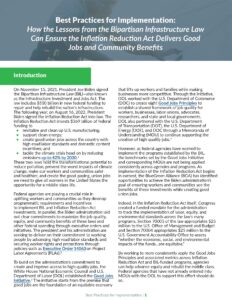 Federal agencies are playing a crucial role in uplifting workers and communities as they develop programmatic requirements and incentives to implement BIL and Inflation Reduction Act investments. In parallel, the Biden administration laid out clear commitments to maximize the job quality, equity, and community benefits of these laws and other federal spending through executive orders and initiatives. The president and his administration are seeking to deliver on their commitment to working people by advancing high-road labor standards and securing worker rights and protections through policies such as Executive Order 14063 on Project Labor Agreements (PLAs). By working to more consistently apply the Good Jobs Principles and associated metrics across Inflation Reduction Act and BIL-funded programs, agencies can help advance equity and rebuild the middle class. Federal agencies that have not already entered into MOUs with the DOL to support this effort should do so.
Federal agencies are playing a crucial role in uplifting workers and communities as they develop programmatic requirements and incentives to implement BIL and Inflation Reduction Act investments. In parallel, the Biden administration laid out clear commitments to maximize the job quality, equity, and community benefits of these laws and other federal spending through executive orders and initiatives. The president and his administration are seeking to deliver on their commitment to working people by advancing high-road labor standards and securing worker rights and protections through policies such as Executive Order 14063 on Project Labor Agreements (PLAs). By working to more consistently apply the Good Jobs Principles and associated metrics across Inflation Reduction Act and BIL-funded programs, agencies can help advance equity and rebuild the middle class. Federal agencies that have not already entered into MOUs with the DOL to support this effort should do so.
ELECTRIC VEHICLE CHARGING INFRASTRUCTURE IMPLEMENTATION GUIDE
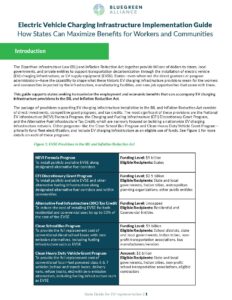 The Bipartisan Infrastructure Law (BIL) and Inflation Reduction Act together provide billions of dollars to states, local governments, and private entities to support transportation decarbonization through the installation of electric vehicle (EV) charging infrastructure, or EV supply equipment (EVSE). States—even when not the direct grantees or program administrators—have the capability to shape what these historic EV charging infrastructure provisions mean for the workers and communities impacted by the infrastructure, manufacturing facilities, and new job opportunities that come with them. This guide supports states seeking to maximize the employment and economic benefits that can accompany EV charging infrastructure provisions in the BIL and Inflation Reduction Act.
The Bipartisan Infrastructure Law (BIL) and Inflation Reduction Act together provide billions of dollars to states, local governments, and private entities to support transportation decarbonization through the installation of electric vehicle (EV) charging infrastructure, or EV supply equipment (EVSE). States—even when not the direct grantees or program administrators—have the capability to shape what these historic EV charging infrastructure provisions mean for the workers and communities impacted by the infrastructure, manufacturing facilities, and new job opportunities that come with them. This guide supports states seeking to maximize the employment and economic benefits that can accompany EV charging infrastructure provisions in the BIL and Inflation Reduction Act.
INFLATION REDUCTION ACT AND BIPARTISAN INFRASTRUCTURE LAW: INVESTMENTS IN ENERGY COMMUNITIES
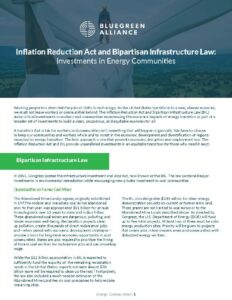 The Biden administration announced several initiatives as leaders from across the country gathered to acknowledge the second anniversary of the founding of the Interagency Working Group (IWG) on Coal and Power Plant Communities and Economic Revitalization. The announcements included new guidance from the Internal Revenue Service (IRS) on the energy communities bonus tax credit established by the Inflation Reduction Act, including what communities will be eligible for the increased credit. In anticipation of the guidance. The BlueGreen Alliance prepared a fact sheet to showcase the available investments to energy communities in the Bipartisan Infrastructure Law (BIL) and the Inflation Reduction Act.
The Biden administration announced several initiatives as leaders from across the country gathered to acknowledge the second anniversary of the founding of the Interagency Working Group (IWG) on Coal and Power Plant Communities and Economic Revitalization. The announcements included new guidance from the Internal Revenue Service (IRS) on the energy communities bonus tax credit established by the Inflation Reduction Act, including what communities will be eligible for the increased credit. In anticipation of the guidance. The BlueGreen Alliance prepared a fact sheet to showcase the available investments to energy communities in the Bipartisan Infrastructure Law (BIL) and the Inflation Reduction Act.
MAKING CLEAN ENERGY TAX CREDITS DELIVER FOR THE PUBLIC: A USER GUIDE FOR GOVERNMENTS, SCHOOLS, AND NONPROFITS
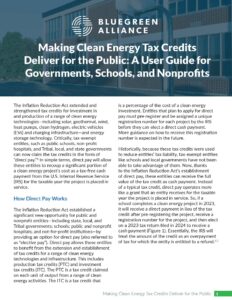 The Inflation Reduction Act extended and strengthened tax credits for investment in and production of a range of clean energy technologies—including solar, geothermal, wind, heat pumps, clean hydrogen, electric vehicles (EVs) and charging infrastructure—and energy storage technology. Critically, tax-exempt entities, such as public schools, non-profit hospitals, and Tribal, local, and state governments can now claim the tax credits in the form of “direct pay.” In simple terms, direct pay will allow these entities to recoup a significant portion of a clean energy project’s cost as a tax-free cash payment from the U.S. Internal Revenue Service (IRS) for the taxable year the project is placed in service.
The Inflation Reduction Act extended and strengthened tax credits for investment in and production of a range of clean energy technologies—including solar, geothermal, wind, heat pumps, clean hydrogen, electric vehicles (EVs) and charging infrastructure—and energy storage technology. Critically, tax-exempt entities, such as public schools, non-profit hospitals, and Tribal, local, and state governments can now claim the tax credits in the form of “direct pay.” In simple terms, direct pay will allow these entities to recoup a significant portion of a clean energy project’s cost as a tax-free cash payment from the U.S. Internal Revenue Service (IRS) for the taxable year the project is placed in service.
DOMESTIC CONTENT BONUS FOR CLEAN ENERGY TAX CREDITS: A USER GUIDE FOR PROJECT DEVELOPERS
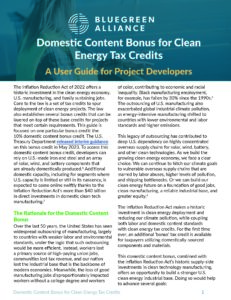 The legacy of outsourcing has contributed to deep U.S. dependency on highly concentrated overseas supply chains for solar, wind, battery, and other clean technologies. As we build the growing clean energy economy, we face a clear choice. We can continue to hitch our climate goals to vulnerable overseas supply chains that are marred by labor abuses, higher levels of pollution, and shipping bottlenecks. Or we can build our clean energy future on a foundation of good jobs, clean manufacturing, a reliable industrial base, and greater equity. The Inflation Reduction Act makes a historic investment in clean energy deployment and reducing our climate pollution, while coupling both labor and domestic content standards with clean energy tax credits. For the first time ever, an additional ‘bonus’ tax credit is available for taxpayers utilizing domestically-sourced components and materials.
The legacy of outsourcing has contributed to deep U.S. dependency on highly concentrated overseas supply chains for solar, wind, battery, and other clean technologies. As we build the growing clean energy economy, we face a clear choice. We can continue to hitch our climate goals to vulnerable overseas supply chains that are marred by labor abuses, higher levels of pollution, and shipping bottlenecks. Or we can build our clean energy future on a foundation of good jobs, clean manufacturing, a reliable industrial base, and greater equity. The Inflation Reduction Act makes a historic investment in clean energy deployment and reducing our climate pollution, while coupling both labor and domestic content standards with clean energy tax credits. For the first time ever, an additional ‘bonus’ tax credit is available for taxpayers utilizing domestically-sourced components and materials.
ENERGY EFFICIENCY AND THE INFLATION REDUCTION ACT: A User Guide for Owners and Developers of Affordable Housing
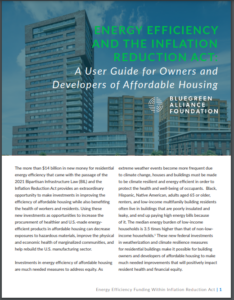
This user guide details four programs being funded through the Inflation Reduction Act that rise to the top as mechanisms to spur investment in energy efficiency upgrades of affordable housing through the work of property owners, homebuilders, developers, and housing coalitions. These programs target the development of affordable single- and multi-family housing and include funds for both new construction and retrofitting of existing buildings. Options for grant funding, loans, tax credits, and product rebates provide several avenues for funding, increasing the affordability and viability of green building measures and providing crucial opportunities to impact the health and wellbeing of low-income populations.
Companies Succeed, Communities Benefit: A Bluegreen Alliance User Guide for Companies to Demonstrate Community Benefits in Federal Funding Applications
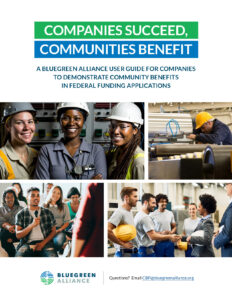 The user guide includes a step-by-step approach and resources to help companies navigate the creation of comprehensive Community Benefit Plans. Some of the funds from the Bipartisan Infrastructure Law (BIL), CHIPS and Science Act, and Inflation Reduction Act are contingent on demonstrating a commitment to creating good jobs and career pathways for a diverse pool of workers, as well as long-term economic, social, environmental, and health benefits for communities.
The user guide includes a step-by-step approach and resources to help companies navigate the creation of comprehensive Community Benefit Plans. Some of the funds from the Bipartisan Infrastructure Law (BIL), CHIPS and Science Act, and Inflation Reduction Act are contingent on demonstrating a commitment to creating good jobs and career pathways for a diverse pool of workers, as well as long-term economic, social, environmental, and health benefits for communities.
